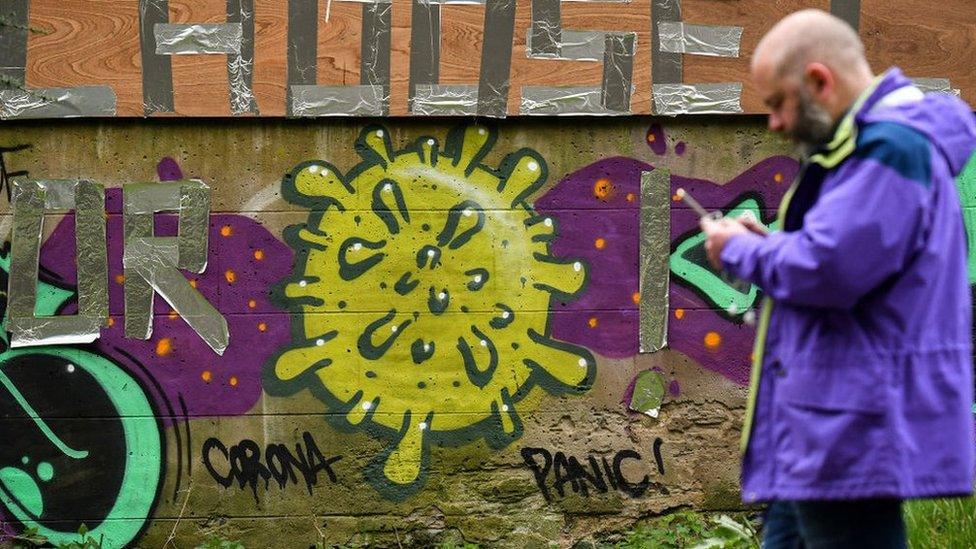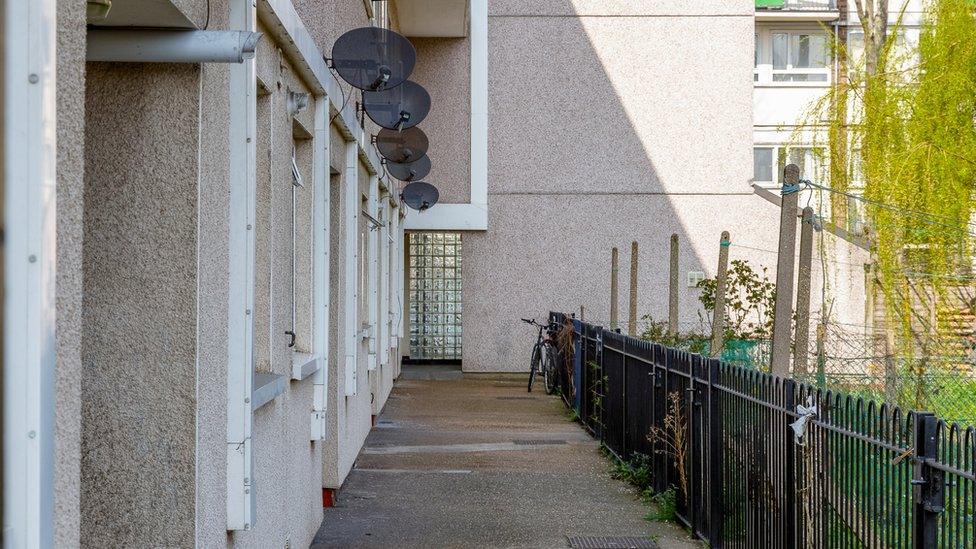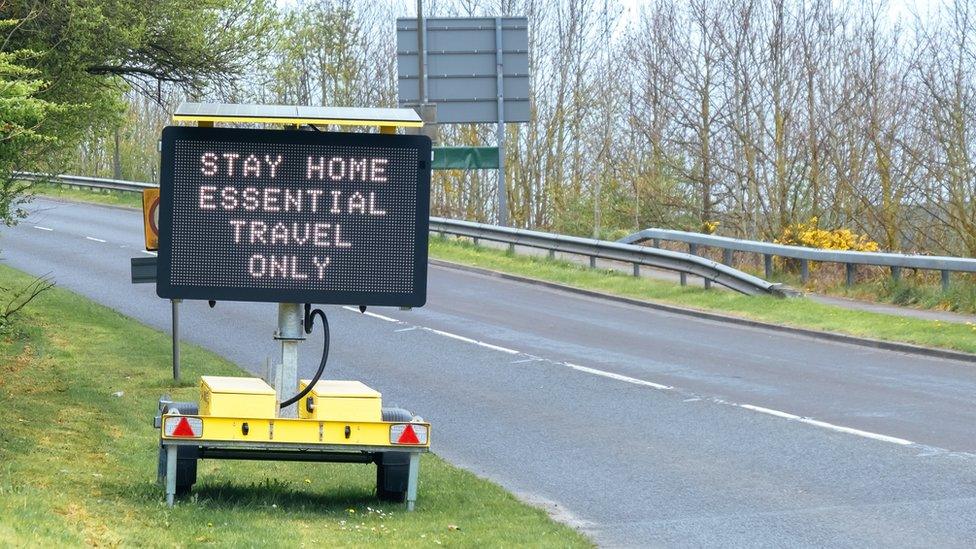Coronavirus: Why might the R number be higher in Scotland?
- Published

The R-value or reproduction number is at the heart of Nicola Sturgeon's decision not to take Scotland out of lockdown. What is the R number and why might it be higher in Scotland than the rest of the UK?
On Thursday, the first minister said it would be "very, very risky" for Scotland to ease its lockdown restrictions.
The reason for this? "The all-important R number".
Ms Sturgeon says the Scottish government is not confident that "R" is comfortably below one, but instead is "hovering around 1".
Deputy First Minister John Swinney was later more specific, saying the number he had seen on Thursday was 0.8, which he said was "far too close" to 1 for Scotland to be relaxing any lockdown measures.
What is R?
Put simply, the R-value is the average number of people an individual would be expected to infect at a point of time during an epidemic.
It's broadly a measure of how easy it is to transmit the disease and how many people the infected person is coming into contact with.
The higher the number, the more out of control a disease is - and even small differences in the number can lead to vastly different infection rates.
If the R-value is above one then the number of cumulative cases takes off, but if it is below one then eventually the outbreak stops. The further below one, the faster that happens.
As Covid-19 can be a deadly disease, this in-turn has a direct link to the number of people who will die, which is why politicians are understandably concerned about the number.
Estimates vary, but it's thought that at the start of the outbreak, the R-value of Covid-19 was about three.
The lockdown measures have helped to drive that figure down - possibly to about 0.7 in the UK as a whole - and the lower the figure, the better.
Graham Medley, professor of infectious disease modelling at the London School of Hygiene & Tropical Medicine, told BBC Newsnight: "We are absolutely sure that R is less than one at the moment, because all the indicators are going downwards. But how far below one it is, is a much more difficult thing to estimate.
"In a sense, we were always in that position. We will never know exactly what that value is. The lower it is the faster we will decrease the numbers of cases. But we are sure it is below one."
Why does the R-value change during an outbreak?
Rowland Kao, external, a professor of epidemiology and data science at the University of Edinburgh, says the R-value will change constantly during the course of an outbreak.
He told BBC Scotland the changes relate to three main factors:
Doing different things to prevent the disease from spreading - for example putting lockdown restrictions in place
The number of people around you who have already been infected. If lots of people around you have had the disease, there are fewer people to pass it on to. This is known as "herd immunity"
Seasonality. We don't yet know if this matters with Covid-19, but it does for some diseases, such as the flu

Herd immunity explained in 65 words...

At a household level, with four people living together, if one person brings in the infection and they isolate together, the first person could pass it on to a maximum of three others. The second person to be infected could only pass it on to two others. R naturally goes down over time. This operates at a community level as well. This is herd immunity.
- Prof Rowland Kao

Why could Scotland's R value be higher than the rest of the country?
The fact that Scotland may have a higher R-value is mentioned in the Scottish government's framework for decision-making, external around Covid-19, and Ms Sturgeon has talked about it on more than one occasion.
Prof Kao points out the R-value "inherently varies", depending on the geographical location and the progress of the outbreak.
For instance, where a disease is "seeded" could mean it inherits a higher R number right at the start, as there are no control measures in place.
He says that one possible factor in Scotland could be that there are two big cities with lots of people living in tenements.

Having high numbers of people living in densely populated areas can affect the R number
These are locations with high numbers of people living in close contact, even when lockdown measures are in place.
And although Scotland has many rural and sparsely populated areas, Prof Kao says the R-value is generated from where the disease is, not where it isn't.
It's very obvious from the data on confirmed cases and deaths that Scotland's Covid-19 outbreak is focused on Glasgow and Edinburgh.
Prof Kao says there is also emerging evidence that deprivation is a big factor in how communities are affected by Covid-19 .
The academic believes we should be asking whether Scotland has places where the level of deprivation is more common than the average, as this could account for the difference in R values.
Deprived areas tend to have people living closer together - making it easier for the disease to transmit - and there are likely to be more underlying health issues in the people living in these communities.
Inverclyde, which has the highest number of Covid-19 deaths per 10,000 people in Scotland, also sits at the top of the Scottish Index of Multiple Deprivation.
Is Scotland 'behind the curve'?

Ms Sturgeon has said the reason for Scotland's higher R-value is because it's "a bit behind the curve".
"If you think back to the start of this epidemic, Scotland's first confirmed case came later than the first confirmed case in England," she told BBC Radio's Good Morning Scotland this week.
This is only "part of the answer", according to Prof Kao.
But he says it could explain the difference in R-value between London and Scotland, arguing that the UK capital has now achieved a level of "herd immunity".
London had coronavirus cases early in the UK outbreak and was hit hard, but the number of cases are now going down.
"In London it's likely there are enough infected people that there is less opportunity to infect others," Prof Kao says.
"London is further down the curve."
Why is R1 the magic number?
Diseases that have very high R-values - for instance measles, which can have a reproduction rate of 15 in populations without immunity - can cause explosive outbreaks.
Prof Kao says that at R equals to one, a disease becomes stable. As soon as the reproduction rate moves above one, it becomes unstable and spreads at a much faster rate.
"That's why the number one is so critical. It tells you that if it's below one the disease is going away," he says.
"Even if it's not completely gone, it's heading in the right direction."
There is also good reason to be cautious with R-values.
Analysis that points to a decreasing R number could be the result of getting a "bit lucky" one week, he says - which is why leaders want to see the R-value significantly lower than one and remaining there for some time.
Control measures like a lockdown have a strong and instant effect on the R number and that's why it's a big factor in any decisions.
As Ms Sturgeon put it in Thursday's Covid-19 briefing: "R must be well below one for a sustained period in order to suppress the virus."
What happens to the R-value when a lockdown is lifted or relaxed?
Inevitably, it goes up.
What's critical is that there are enough resources to cope with the rise and that it doesn't push the disease above one and into instability.
"What you don't want it to do is to go up high enough that it increases the risk of overburdening the health care system and care homes," Prof Kao says.
The other danger is that you can also see a "snowballing" effect following the relaxation of restrictions, which can create a "perfect storm".
Prof Kao says this could happen in care homes, a system that is already "highly stressed".

Almost 60% of Covid-19 deaths in Scotland are now in care homes
Here's how Prof Kao explains this snowballing effect:
There are a finite number of care workers and if they become infected, they isolate.
Because you can't instantly make more care workers, those left have to do more. They spend more time in care homes, circulate around more beds and perhaps even go into different care homes.
This places them at increased risk of being infected and infecting others. At some point they will become sick and need to isolate - and so it continues.
At the same time, it risks the lives of those most vulnerable to a Covid-19 infection - the elderly residents of the care home.
It's likely that this is one of the "catastrophic" effects the first minister has in mind when she says Scotland is not ready to see restrictions eased.
How do you measure the R number?
There is a lot of complex maths behind R-value calculations, but Prof Kao says that governments will be playing close attention to the number of people dying.
He says that it's a reliable measure for calculating the R number because you can be reasonably sure that the data is "robust".
If the death rates are higher than elsewhere, it tells you that there is something going on, he says.
In Scotland, analysis of Scotland's death rate show it has been plateauing for some weeks, with only small declines seen in recent days.

Prof Kao says this measure could be one of the reasons the Scottish government is continuing to urge caution - a caution which may ultimately put Scotland on a different path to other parts of the UK.
"If the death rate is plateauing here and in other places it's going down, it may be an indication the disease is not as under control," he says.